Abstract
One of the main objectives of the European FP7 PROFILES Project was to promote Science teaching through specific methods (as IBSE), with the view to improve the students’ scientific literacy. In such a perspective, Science teachers - Physics, Chemistry, Biology -, as reflective practitioners, should be concerned by students’ motivation for learning, which allows them to be actively involved in the act of learning, to capitalize their own resources, to act, to investigate, to experiment, to seek, to find, to develop scientific hypotheses and resolute strategies, to develop their argumentation capacity and decision-making competence. The paper try to investigate the teachers’ perception concerning the students’ motivation for learning, which can be optimized in classrooms if the teachers: (a) create motivational challenges for students according to their capabilities; (b) guide students to value Science learning as useful for their life, lifelong learning and for their career choice; (c) use related media texts and video-clips; (d) use (extract, draw) interesting and suitable examples of the history of Science; (e) determine relevant topics, encouraging students’ self-motivation.
Keywords: PROFILES Projectstudents’ motivation for learningintrinsic motivationextrinsic motivationSciences teachers
Introduction
In the
The PROFILES CPD programme aimed to make science learning and science specific topics more interesting, relevant and meaningful for students. Achieving this goal is not exactly an easy issue, because science, as a particular area, but also teaching science, are not interesting for most of the nowadays students. Science lessons are often described as boring and irrelevant (Braund, 2008, p. 50) and, in this sense, the PROFILES project tried to solve at least a part of this problem (Petrescu et al., 2015).
As a reflective practitioner, the science teacher should be concerned by the best ways to increase the students’ learning motivation, which allows them to be actively involved in the act of learning, to capitalize their own resources, to act, to investigate, to experiment, to seek, to find, to develop scientific hypotheses and resolute strategies, to develop their argumentation capacity and decision-making competence.
Increasing the students’ learning motivation in science lessons represents a real challenge for teachers.
Learning motivation refers to “all the factors that mobilize the student in an activity intended to lead to the assimilation of knowledge, to the development of skills and abilities. Motivation energizes and facilitates learning by enhancing student effort and focus student attention, creating a state of readiness for the learning activity. Motivated students are more assiduous and learn more effectively” (Sălăvăstru, 2004, p. 70).
Learning motivation - in terms of education through science -, is a set of dynamic factors which determine students to learn new scientific contents or participate in scientific activities (Gorghiu, & Drăghicescu, 2014). We can distinguish two types of motivation in learning activity: (a)
Also, Ryan and Deci (2002, apud. Holbrook, Rannikmäe & Valdmann, 2014), in their self-determination theory, suggest that motivation can be sub-divided into intrinsic and extrinsic forms. As students’ extrinsic motivation is promoted by external aspects, it is very susceptible to the continuing impact of such external components (learning environment). An obvious example is the role played by the teacher and the aspects under the teacher influence such as students’ attention, participation and follow-up.
On the other hand, the intrinsic motivation is influenced by internal student matters, such as relevance, familiarity and prior interests.
Cavas (2011, apud. Holbrook, Rannikmäe & Valdmann, 2014), suggests five important factors for motivation in science learning: student self-efficacy, value (relevance/usefulness) of science learning value, learning strategies, individual’s learning goals, and, inevitably, the learning environment. It is also suggested that the classroom learning environment - created by the teacher - and the students’ own self-disposition have also impact on motivation. In addition, cognitive stimulation, or if preferred, a suitable challenge within the zone of proximal development (Vygotsky, 1978, apud. Holbrook, Rannikmäe & Valdmann, 2014), can be added.
In PROFILES, a major objective is to ensure the students’ intrinsic motivation. This type of motivation is initiated by the students who want to know more, so it is an internal motivation. In other words, PROFILES initiates the learning of a subject in a manner that is inherently interesting to students. This interest is promoted by presenting learning as relevant to students.
Methodology
The aim of our investigative approach, developed in the PROFILES project -
The questionnaire was applied to 100 science teachers (Physics, Chemistry, Biology) who acted in the lower and secondary school levels.
The items of the questionnaire refer to some important aspects of students’ motivation for learning such as: create motivational challenges for students within their capabilities, guide students to value their science learning as useful for life, lifelong learning and for their career choice, use media texts and video clips, encourage self-motivation by students in science lessons, determine relevant topics, in the eyes of the students.
The items were structured into two assessment scales, with four steps each, the first one concerning the teachers’ confidence about certain aspects of the students’ motivation for learning, and the second regarding the emphasis for CPD, the need to integrate such issues in professional development programmes. The scale for confidence was:
The data processing was mostly statistical, in correlation with the qualitative analysis, based on the data gathered from discussions with the involved teachers.
In our study, we chose (for presenting and analyzing) five relevant items in the questionnaire and we made a comparative analysis of the results from the two mentioned points of view:
Results and discussions
The first of those items refers to the creation of the motivational challenges for students within their capabilities.
To increase the motivation for learning activities, the students must be constantly challenged with tasks that relate to previous skills and knowledge, which are suitable for students’ capabilities.
Analyzing the data obtained from this item (Fig. 1), we can observe that the results are distributed to the right side of the scale, both in terms of confidence (well - 28%, very well - 44 %) and in terms of emphasis for CPD (necessary - 54%, very necessary - 46%). The results demonstrate the importance of creating motivational challenges according to students’ capabilities and competences, and teachers’ needs to learn more about the best ways of create motivational challenges in science lessons.
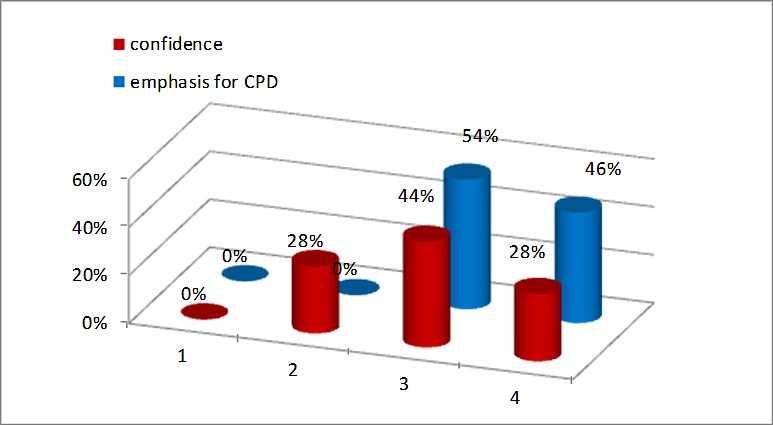
The second analyzed item refers to the guidance of the students to value their science learning as useful for life, lifelong learning and for their career choice.
The usefulness of the knowledge acquired in the science lessons, connected with the everyday life, and also necessary for the future careers, is a very important aspect that may increase the students’ motivation for learning. In this context, the teacher must assume the role of a guidance actor, that helps students become aware of professional contexts or everyday contexts, in which they can actually use the knowledge acquired in science lessons, as confirmed by the results (Fig. 2). From the perspective of surveyed teachers, the confidence in motivating students by promoting such teaching behavior in the classroom is well (43%) and very well (43%) represented. Teachers consider necessary and very necessary to integrate such subject in the professional development program, which can lead us to the conclusion that they feel inadequately prepared to assume such role in their lessons.
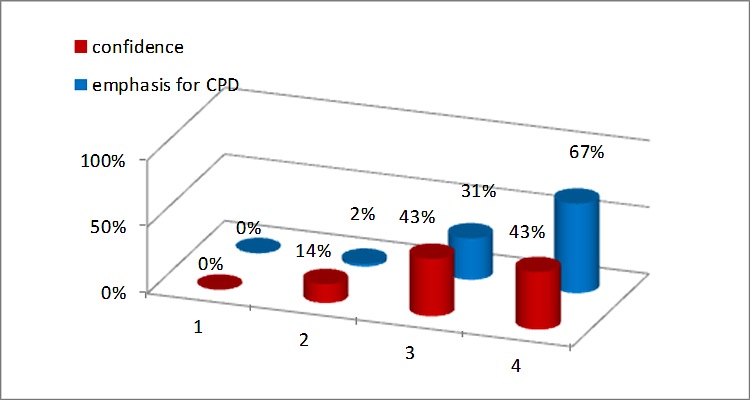
The next selected item concerns the use of media texts and video-clips in science lessons, as modern teaching materials.
To effectively teach content specific to science area and to harness individual differences and different learning styles, media text and video-clips may be used in the lessons. Those are modern teaching materials and if they are valued in the science lessons, they can increase the students’ learning motivation and lead to a proper understanding of the knowledge and to an effective learning.
The obtained results (Fig. 3) confirms the idea stated above, teachers expressing confidence in motivating students by using such modern technological tools (the percentages being well - 52% and very well - 28 %). We can also observe that a very high percentage of respondents (48%) consider very necessary to approach such subject in a future professional development program.
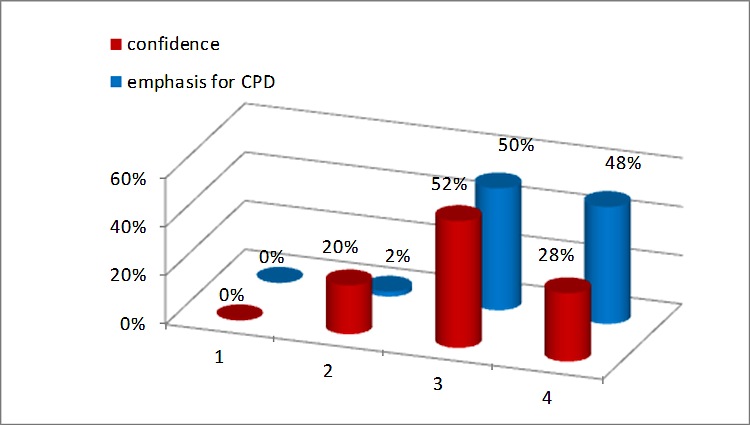
Another important item for our study refers to encouraging self-motivation of the students in science lessons.
The transition from motivation to self-motivation is a challenge both for teachers and students. A student is self-motivated when he/she becomes able to go through a learning activity that matches his own goals, objectives, aspirations. In such a situation, the student’s behavior is entirely self-determined. So, encouraging students to develop self-motivation in science lessons becomes very important. This idea is confirmed by the responses of surveyed teachers who want to be trained about the ways in which students can develop intrinsic motivation and self-motivation (Fig. 4).
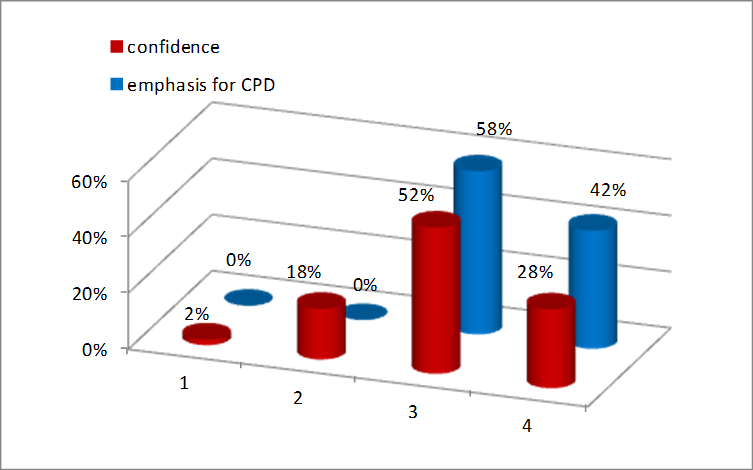
The last selected item refers to the relevance of the science topics, in the eyes of the students.
The relevance refers to how significant is the learned material. The relevance depends on the significance of the topic for the student, where the subject is “associated” with intelligibility, with the opportunity to participate, with the classroom atmosphere, with the level of satisfaction and performance perceived by the student in relation with what he/she learned.
To be more relevant to students, science teaching requires student participation in choosing suitable social environment for learning science, requiring a multiplication of student’s activities and self-instruction opportunities, more possible ways to assess the effectiveness of teachers and maximizing the involvement of students and eliminate teacher-centered approaches.
Therefore, it is very important that teachers must know very well which are the subjects that are relevant to students. The results obtained (Fig. 5) in this item confirms this idea, a high proportion of teachers expressing their confidence that such activity may increase the students’ motivation for learning. It also hopes that such a problem will be integrated in a teacher training program.
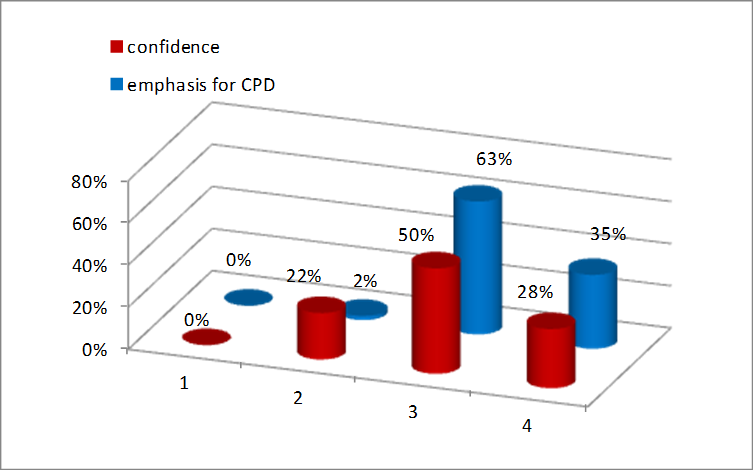
Comparing the percentages obtained in each analyzed item, we find that those relating to the emphasis for CPD are higher than those on confidence in the manifestation of such issues in the classroom. The reason for this situation may be that teachers consider important all the aspects related to students’ motivation for learning, but they are aware of their limits related to how to handle all those aspects in the classroom and they are interested in participating in a training program that empower them in this problem.
Conclusions
The results of our study lead to the following conclusions:
science teachers consider that learning motivation, with all the specific aspects (create motivational challenges for students within their capabilities, guide students to value their science learning as useful for life, lifelong learning and for their career choice, use media texts and video-clips, encourage self-motivation by students in science lessons, determine relevant topics, in the eyes of students) represents an important factor that needs to be harnessed in the science lessons;
teachers are aware that they must do significant changes in the manner of teaching science and they must use new, attractive and modern ways on motivating the students;
the answers given by the teachers indicated that they want to be involved in a training program which integrate the issue of learning motivation, and to learn more about how to act in the classroom.
Learning motivation is a very important variable in the educational process and without it we can’t talk about effective, profound and sustainable learning. Corroborating this idea with the idea that lately, the students’ interest in science area is declining, science teachers should reflect on their own activities, in order to identify and use the best ways to stimulate the students’ learning motivation and guide them on their way from motivation to self-motivation. Just in this case, the students will have success in school, but also in their future career and in the society.
Acknowledgements
This work was funded through the Seventh Framework Programme “
References
- Braund, M. (2008). Starting Science - Again? Making Progress in Science Learning. London: Sage.
- Gorghiu, G., & Drăghicescu, L. M. (coord.) (2014). Educaţie prin Ştiinţe. Aspecte referitoare la instruirea bazată pe investigaţie ştiinţifică. Târgovişte: Bibliotheca.
- Holbrook, J., Rannikmäe, M., & Valdmann, A. (2014). Identifying teacher needs for promoting Education through Science as a paradigm shift in Science Education. Science Education International, 25(2), 4-42.
- Neacşu, I. (1978). Motivaţie şi învăţare. Bucureşti: EDP.
- Petrescu, A. M. A., Negreanu, M., Drăghicescu, L. M., Gorghiu, G., & Gorghiu, L. M. (2015). Innovative Aspects of the PROFILES Professional Development Programme Dedicated to Science Teachers. Procedia - Social and Behavioral Sciences, 191, 1335-1360.
- Sălăvăstru, D. (2004). Psihologia educaţiei. Iaşi: Editura Polirom.
Copyright information

This work is licensed under a Creative Commons Attribution-NonCommercial-NoDerivatives 4.0 International License.
About this article
Publication Date
22 December 2016
Article Doi
eBook ISBN
978-1-80296-017-4
Publisher
Future Academy
Volume
18
Print ISBN (optional)
-
Edition Number
1st Edition
Pages
1-672
Subjects
Teacher, teacher training, teaching skills, teaching techniques, special education, children with special needs
Cite this article as:
Stăncescu, I., Drăghicescu, L. M., & Santi, E. A. (2016). A Science Teachers’ Perspective Related to the Students’ Motivation for Learning. In V. Chis, & I. Albulescu (Eds.), Education, Reflection, Development - ERD 2016, vol 18. European Proceedings of Social and Behavioural Sciences (pp. 615-622). Future Academy. https://doi.org/10.15405/epsbs.2016.12.76

